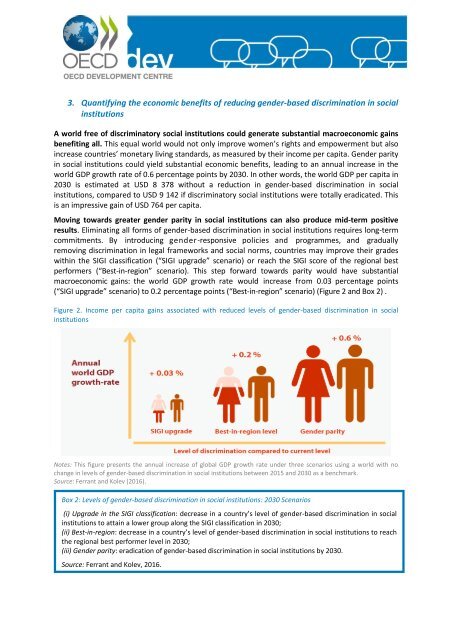2eBpQex
2eBpQex
2eBpQex
You also want an ePaper? Increase the reach of your titles
YUMPU automatically turns print PDFs into web optimized ePapers that Google loves.
3. Quantifying the economic benefits of reducing gender-based discrimination in social<br />
institutions<br />
A world free of discriminatory social institutions could generate substantial macroeconomic gains<br />
benefiting all. This equal world would not only improve women’s rights and empowerment but also<br />
increase countries’ monetary living standards, as measured by their income per capita. Gender parity<br />
in social institutions could yield substantial economic benefits, leading to an annual increase in the<br />
world GDP growth rate of 0.6 percentage points by 2030. In other words, the world GDP per capita in<br />
2030 is estimated at USD 8 378 without a reduction in gender-based discrimination in social<br />
institutions, compared to USD 9 142 if discriminatory social institutions were totally eradicated. This<br />
is an impressive gain of USD 764 per capita.<br />
Moving towards greater gender parity in social institutions can also produce mid-term positive<br />
results. Eliminating all forms of gender-based discrimination in social institutions requires long-term<br />
commitments. By introducing gender-responsive policies and programmes, and gradually<br />
removing discrimination in legal frameworks and social norms, countries may improve their grades<br />
within the SIGI classification (“SIGI upgrade” scenario) or reach the SIGI score of the regional best<br />
performers (“Best-in-region” scenario). This step forward towards parity would have substantial<br />
macroeconomic gains: the world GDP growth rate would increase from 0.03 percentage points<br />
(“SIGI upgrade” scenario) to 0.2 percentage points (“Best-in-region” scenario) (Figure 2 and Box 2) .<br />
Figure 2. Income per capita gains associated with reduced levels of gender-based discrimination in social<br />
institutions<br />
Notes: This figure presents the annual increase of global GDP growth rate under three scenarios using a world with no<br />
change in levels of gender-based discrimination in social institutions between 2015 and 2030 as a benchmark.<br />
Source: Ferrant and Kolev (2016).<br />
Box 2: Levels of gender-based discrimination in social institutions: 2030 Scenarios<br />
(i) Upgrade in the SIGI classification: decrease in a country’s level of gender-based discrimination in social<br />
institutions to attain a lower group along the SIGI classification in 2030;<br />
(ii) Best-in-region: decrease in a country’s level of gender-based discrimination in social institutions to reach<br />
the regional best performer level in 2030;<br />
(iii) Gender parity: eradication of gender-based discrimination in social institutions by 2030.<br />
Source: Ferrant and Kolev, 2016.










